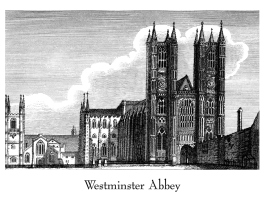About the Westminster Standards
The Westminster Standards is a collective name for the documents drawn up by the Westminster Assembly (1643–49). These include the Westminster Confession of Faith, the Westminster Shorter Catechism, the Westminster Larger Catechism, the Directory of Public Worship, and the Form of Church Government,[1] and represent the doctrine and church polity of 17th-century English and Scottish Presbyterianism. The Westminster Confession of Faith and Larger and Shorter Catechism have been adopted as doctrinal standards by a number of Reformed and Presbyterian Christian denominations.[2][3]
Following the approval of the Confession and catechisms by the Church of Scotland in 1648, printers in England and Scotland began publishing them with other religious documents in collections referred to as the Westminster Standards. In 1658 printers began including the full Scripture passages which are cited in the confessional documents. These collections became standardized in a 1728 edition, which follows a 1679 work published by Covenanters exiled in Holland and contains twenty-two documents including parliamentary acts related to the Assembly and devotional works. These collections were intended to serve as ecclesiastical manuals as well as comprehensive popular religious books. The 1728 form of the Standards continues to be printed by the Free Presbyterian Church of Scotland.[4]
In the nineteenth century, several churches separated from the Church of Scotland on the basis of the established church’s departure from a list of documents similar to those found in standard collections of the Westminster Standards. Dissenters asserted that the General Assembly had adopted these documents, but the only Westminster documents accepted by the Church of Scotland were the Confession and catechisms.[5]
from Wikipedia, the free encyclopedia
Westminster Confession of Faith (1647)
The Westminster Confession of Faith is a Reformed confession of faith. Drawn up by the 1646 Westminster Assembly as part of the Westminster Standards to be a confession of the Church of England, it became and remains the “subordinate standard” of doctrine in the Church of Scotland, and has been influential within Presbyterian churches worldwide.
Reformed confession of faith. Drawn up by the 1646 Westminster Assembly as part of the Westminster Standards to be a confession of the Church of England, it became and remains the “subordinate standard” of doctrine in the Church of Scotland, and has been influential within Presbyterian churches worldwide.
In 1643, the English Parliament called upon “learned, godly and judicious Divines”, to meet at Westminster Abbey in order to provide advice on issues of worship, doctrine, government and discipline of the Church of England. Their meetings, over a period of five years, produced the confession of faith, as well as a Larger Catechism and a Shorter Catechism. For more than three centuries, various churches around the world have adopted the confession and the catechisms as their standards of doctrine, subordinate to the Bible.
The Westminster Confession of Faith was modified and adopted by Congregationalists in England in the form of the Savoy Declaration (1658). Likewise, the Baptists of England modified the Savoy Declaration to produce the Second London Baptist Confession (1689). English Presbyterians, Congregationalists, and Baptists would together (with others) come to be known as Nonconformists, because they did not conform to the Act of Uniformity (1662) establishing the Church of England as the only legally approved church, though they were in many ways united by their common confessions, built on the Westminster Confession.
from Wikipedia, the free encyclopedia
